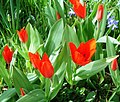Stinzen plant

Stinzen plants (also stinzen plants ) are a group of agriophytes , i.e. plants introduced by humans at the observed location. With regard to their occurrence and their distribution in northern Central Europe, they represent a special feature, because after being planted in a (suitable) location they survive, multiply and grow wild without human influence. This makes them part of the natural vegetation. However, their distribution is usually limited to the immediate area of their original planting even over long periods of time.
Occurrences of these plants are therefore cultural relics and their occurrence (e.g. on lawns , in bushes) indicates that there was a garden or the like in the respective area. A considerable part of the stinzen plants belongs to the spring bloomers .
Origin of the term
The term is derived from the Frisian term for "stone house". In earlier centuries (especially in the late Middle Ages and early modern times ) stone houses were an exception due to the higher construction costs. Most stone houses were castles , monasteries , mansions , manors , churches and pastorates . These stone houses often had gardens or gardens / parks where u. a. Ornamental plants were planted - including flowering plants, which are now known as "stinzen plants". While the stone houses over time z. Some of them disappeared and / or the gardens or gardens / parks were redesigned or closed, the ornamental plants that were not native to them have been preserved to this day and provide an indication of the original gardens and their extent.
List of stinzen plants (selection)
- Common star hyacinth ( Chionodoxa luciliae )
- Amethyst squill ( Chouardia litardierei )
-
Crocuses ( crocus )
- Elven crocus ( Crocus tommasinianus )
- Spring crocus ( Crocus vernus ), including Crocus napolitanus
- Winterling ( Eranthis hyemalis )
- Chess flower ( Fritillaria meleagris )
- Little snowdrop ( Galanthus nivalis )
-
Grape hyacinths ( Muscari )
- Armenian grape hyacinth ( Muscari armeniacum )
- Small grape hyacinth ( Muscari botryoides )
- Daffodils ( Narcissus ) (original / old varieties )
- Nodding Milky Star ( Ornithogalum nutans )
- Siberian squill ( Scilla siberica )
- Wild tulip ( Tulipa sylvestris )
- Small periwinkle ( Vinca minor )
White grape hyacinth
Daffodils of different colors
Wild tulip
Examples of occurrences of stinzen plants
| scientific name | Common name | place | image | Remarks |
|---|---|---|---|---|
| Crocus napolitanus | Husum Castle Park |  |
Nationally known event of the Husum crocus blossom | |
| Eranthis hyemalis | Winterling | Rautal , Jena |  |
|
| Fritillaria meleagris | Chess flower | NSG Schachblumenwiesen near Sassenberg |  |
presumably garden refugees from the former palace garden |
| Ornithogalum nutans | Nodding Milky Star | Park of the Paretz Castle | ||
| Scilla siberica | Siberian squill | North Park Magdeburg |  |
|
| Scilla siberica | Siberian squill | Lindener Berg district cemetery , Hanover |  |
|
| Tulipa sylvestris | Wild tulip | at Brake Castle , Lemgo | presumably overgrown from a baroque garden |
swell
- Hans-Helmut Poppendieck: Historical ornamental plants in Schleswig-Holstein gardens and parks - in: Adrian von Buttlar / Margita Marion Meyer (ed.): Historical gardens in Schleswig-Holstein , Heide 1996, ISBN 3-8042-0790-1
- Hans-Helmut Poppendieck: Stinzen Plants in Schleswig-Holstein and Hamburg - in: Adrian von Buttlar / Margita Marion Meyer (Ed.): Historical Gardens in Schleswig-Holstein , Heide 1996
- Christian Stolz (2013): Archaeological indicator plants: case studies from the Taunus and northern Schleswig-Holstein. Plants as indicators for archaeological find sites: Case studies from the Taunus Mts. and from the northern part of Schleswig-Holstein (Germany) . - Writings of the Regional and Folklore Working Group 11: 1–30
- Herbert Sukopp & Ingo Kowarik (2008): Stinzen plants in Central Europe and their agriophytic occurrence. Reports from the Institute for Landscape and Plant Ecology at the University of Hohenheim, issue 17, 2007, pp. 81–90. PDF
- Book Tuinieren met Stinzenplanten, Trudi Woerdeman, Dieren 2008. http://www.starkezwiebeln.de/buch-tuinieren-met-stinzenplanten
- ↑ Rare vineyard tulips blooming at Brake Castle , website of the Landesverband Lippe, April 27, 2018















